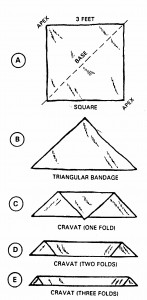If you do not have a field tourniquet available, you can make an improvised tourniquet. You will need a tourniquet band, a rigid object, and padding materials.
Additional securing material may also be needed.
a. Tourniquet Band.
Obtain a band of strong, pliable, folded material which is at least two inches wide. A cravat made from a folded muslin bandage (figure 2-11) is preferred. A folded handkerchief, a folded strip of clothing, or a belt can also be used as the tourniquet band. Do not use wire, shoestrings, or other narrow materials for the tourniquet band. A wide tourniquet band protects the tissues beneath the tourniquet when it is tightened. Very narrow materials may result in serious damage to the nerves and blood vessels when the tourniquet is tightened.

b. Rigid Object.
Obtain a rigid object, usually a stick, which is long enough and sturdy enough to tighten the tourniquet band and be secured.
c. Padding.
Obtain padding material to be placed between the limb and the tourniquet band to protect the skin from being pinched and twisted when the band is tightened. Soft, smooth material should be used for the padding. The casualty’s shirt sleeve or trouser leg can be used as padding.
d. Securing Materials.
Obtain material to be used to secure the rigid object once the tourniquet band has been tightened. If the cravat used as a tourniquet band is long enough, the tails of the cravat can be used to secure the rigid object. Another cravat or strip of cloth similar to the tourniquet band can be used to secure the rigid object.
